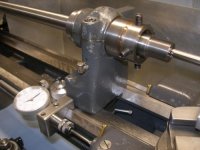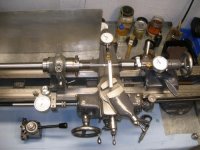geo.ulrich
Member
No...using the steady-rest is not inferior: http://youtu.be/R7CZaBO8jNA
Greg they won't get it and yes I use a steady rest and indicate both ends lets see if that can be figured out...see ya in may George
Last edited:
No...using the steady-rest is not inferior: http://youtu.be/R7CZaBO8jNA
Can you explain how when you put a barrel through a spindle the bore becomes magically straight, I'm pretty sure any bow is still there same as in a steady rest..
Jerry ask George how to do it.
Hey Toot, I thought I just did.
Come to River Bend and shoot with me. Jeff said Lisa is having surgery and he can't make it.
......... I have come across a few barrels that have as much as 0.003" curve in that distance.....
I'm guessing Jerry's talking about a PPC here, on a thick, short BR-tapered 22 or 6mm blank............
Try a 30-06 or an Ultra-Mag or a less standard 7MM or 8MM barrel and see some real runoutor, recently, I've been playing with 50's........
Or try trusting a fluted 30" hunting rifle tube.....
Nahhh, we "don't get it," not A'Tall.....
between centers that is.....
LOL
al
Greg, can you video how you have trued the muzzle end in this setup and how you prepped the tenon for turning?
Jerry,
I don’t really have the time to put a video demonstration together, but if you can read my post #10 here for a simple explanation: http://benchrest.com/showthread.php?87931-kelbly-video-on-accurate-shooter&p=718373&highlight=
I don’t normally like to interject or get into the fray on these forums…or start arguments just to make noise. I know that good quality barrel work can be accomplished with “through the headstock” methods, but when I see claims that a well-established machining procedure is inferior to some of the convoluted ways that hobbyists dream up to chamber a rifle barrel, I feel inclined to dispel those myths.
it does not..we never said it did...
but you can dial in the bore AT THE THROAT. THAT ALONG WITH DRILL, TAPER BORE, AND TURNING THE OD BASED ON THE THROAT....gives a straight chamber with a bullet straight inline with the bore at the point it engages the bore.
its pretty simple...
at what point in the bore did you dial it in ??
1/2", 1",2".. ??at the throat of the new chamber ??
if the tip of the reamer follows the bore, what is the back of the reamer doing ??
Jerry,
I don’t really have the time to put a video demonstration together, but if you can read my post #10 here for a simple explanation: http://benchrest.com/showthread.php?87931-kelbly-video-on-accurate-shooter&p=718373&highlight=
I don’t normally like to interject or get into the fray on these forums…or start arguments just to make noise. I know that good quality barrel work can be accomplished with “through the headstock” methods, but when I see claims that a well-established machining procedure is inferior to some of the convoluted ways that hobbyists dream up to chamber a rifle barrel, I feel inclined to dispel those myths.
I have done 25/264 Win Mag Improved chambers in 28" Douglas barrels this way does that count?
Talk about a great 600 yard deer round, the 25/264 Whammy (WMI) is!!
OK..... you've been honest here re your methods. You've been a big proponent of the long stemmed test indicator. And you've posted plenny pix..... care to share a pic of the indicator you used to dial in the chamber and throat on this guy? If it's commercially available I don't know where! Al, its just a long stem, I forgot from where, nut I think it was from www.longislandindicator.com
Exactly how did you know where to aim to hit the throat on a .264 Win Mag? I ran the indicator stem in the measured amount to where the chamber throat front would finish. These are on Rem 700 actions so it just has to reach about 2 1/2"
Could you make 5 of them that use the same FL die? Will they interchange loaded rounds? Years apart? Dunno?? I have only done 4 of these and only one was a repeat on the same action. The other 2 are in NW Kansas and still working.
(And this question is for JERRY because he DOES know what I'm asking. He doesn't choose to agree with GG but he's convinced me he DOES understand the methodology, just doesn't subscribe to it. Doesn't believe in it. Jerry Sharrett doesn't blow smoke up my butt with insinuations.....)
I'll try my best to understand
al
Posting a pix, sorry but I am packing and loading for the River Bend shoot and doing a bunch of other stuff. The Interapid stem is just a longer one than the one I use for a PPC. It measures 2 7/8" long so it is not a 1:1 reading, but if I get to read zero I'm pretty close.
Greg, you and I can further discuss this in May. My disliking the piloted center with the journal turned from that point is that in a really crooked barrel (crooked at the butt end) the finished chamber neck area may still be running out 0.002"-0.003". Even with a snugly piloted reamer there may still be misalignment at the chamber neck/freebore area. I don't have confidence in a barrel that has two leade ramps of one length and two of another.
In situations where some of you have lathes with headstocks too thick to let the barrel stick out and have to run it in an inboard bushing, that is the best you can do. What I have against that method is that when changing barrels the POI of the new barrel may be off 4"-8" from the previous barrel. Being able to indicate the bore on both ends the barrel change doesn't change the POI but a couple of inches.
As to getting into frays and starting arguments, I hate that too!!! And to think, John Lewis accused me of being opinionated???
(can't wait for my surprise)


Actually Jerry, your reasons for using your method are the same reasons why I prefer using the steady rest. I can avoid cutting elliptical chambers and tenons that aren’t perpendicular with the receiver face by establishing a true center in relation to where the pilot registers during reaming. By machining two journals at the ends of the barrel to be true to the bore – the steady rest, chuck jaws, and quill of the tailstock will now be perpendicular to each other and the center axis of the barrel…rather than the barrel rotating around an arbitrary point in space as it sometimes can when doing the job through the headstock. You'll have to 'splain this to me later.
For example, we installed a dozen HV Bartlein 1-11.25” 5-R barrels on rifles that we sent to our mutual buddy in Thiland last year and test fired them – removing and installing a single bore-sighted scope from one rifle to the next. Without moving the windage and elevation adjustments, EACH RIFLE shot within 2 MOA from the original POI. Incidentally, these were HV BR rifles chambered in 308 Win. CIP specs. With Lapua 185g factory ammo, three shot groups (after the initial sighting shot) with EVERY RIFLE were all under 0.3 MOA. I'm still in disbelief that factory ammo in a standard chamber shot that well.Wonder what cute sweet little Supreeya is doing with a dozen 308 HV barrels? Or did you already tell me?
Greg Walley
Kelbly’s Inc.
no you missed the part...where i have lathe experience, and little gunsmith experience...
jackie s is my online mentor...
why ?
because he took years of machine experience and applied it to chambering.
unlike the typical gunsmith that is taught just enough to barely use a lathe as just part of his job.
half of you guys are lemmings...doing how it was taught and never asking why or is there a better way.
al, jackie and i all understand the basics of machining..and applied it to a better chamber process......dial in the throat. use it as the basis of all receiver end machine work.
why
so the bullet is straight when it enters the bore.......
Gee, I have been called a lot of things but never a LEMMING, sounds a lot like that guy from Colorado A couple of questions if you have lathe experience why would you need a mentor any 6 month apprentice can chamber a barrel straight. 2nd when you dial in throat I agree chamber is straight at that point but what about in front, so your bullet is straight entering a bore that is still running out. By the way I am pretty sure Jackie is a little further then the basics at least when I met and talked with him he did.
